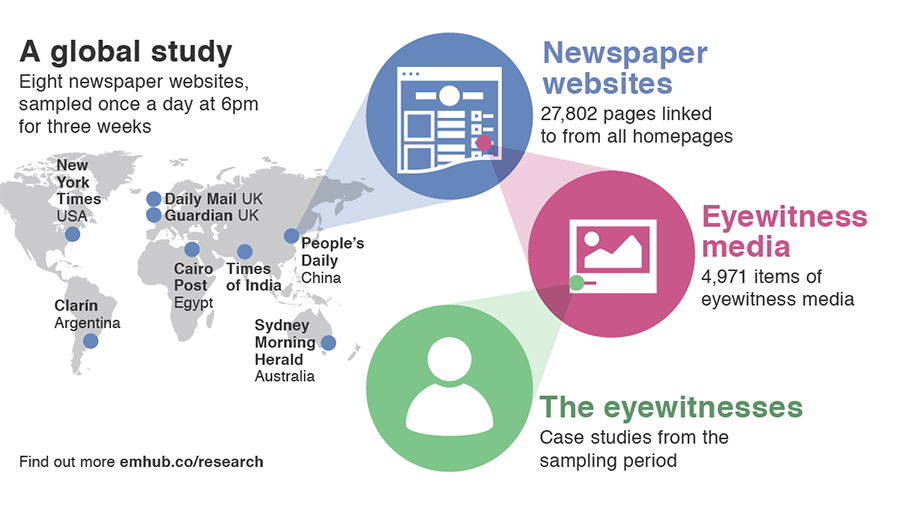Abstract
We wanted to know how some of the most popular online newspaper sites use eyewitness media. We chose eight publications from around the world, and then every day for three weeks (21 consecutive days), we digitally captured their homepages, as well as all of the articles linked to from those homepages.
We analysed each example to understand when, where and how eyewitness media is being used by the most popular online newspaper sites.
We then contacted a number of eyewitnesses whose content had been published during our three week sampling period to provide a snapshot of some of the emerging issues relating to rights, permission, crediting and context.
Introduction
Last year, Claire Wardle, Sam Dubberley and I – co-founders of Eyewitness Media Hub – launched our first major study into eyewitness media and the news media (Wardle et al., 2014a). That research, which focused on the output of eight global TV channels and their websites, shone a light on a number of issues around broadcasters’ use of eyewitness media, particularly in the areas of crediting and labelling. We were adamant that project should represent the beginning, rather than the end, of our research endeavours. Accordingly, this report contains a detailed study of how eyewitness media is used by eight major newspaper websites – online versions of established print publications – from around the world. As such, it marks the latest instalment in our ongoing commitment to assessing and understanding the landscape in this exciting and rapidly evolving area of journalism.
This piece of research gives us more compelling evidence that not only is it an integral part of both soft and hard news coverage, but more must be done to raise awareness around the rights of and responsibilities towards eyewitnesses.
Given that eyewitness media is synonymous with the online world, we have been keen to undertake a systematic analysis of when, where and how this content is used by some of the web’s major players. Online news outlets represent a very different proposition to their more established counterparts in TV because there are fewer limits to the format and they enjoy the luxury of near limitless space. Newspapers represent a particularly fascinating proposition in the contemporary media climate because, while many are struggling to sustain their legacy products in the face of rapidly declining sales and dwindling advertising revenues, a number of the sites in our sample can lay claim to being among the most popular news outlets on the web.
Acutely aware that they are not just in competition with each other but every other news outlet on the web, many newspapers have sought to adapt their workflows and digital strategies to incorporate eyewitness media. It has become commonplace to see online news sites imploring their loyal readers to contribute photos and videos during breaking news events, while some have established their own independent platforms to allow readers to share content relating to specific assignments set by dedicated editorial teams, as with the Guardian newspaper’s GuardianWitness initiative. Elsewhere, high profile examples of newspapers breaking eyewitness media-centric stories are numerous. One example occurred in February 2015, when the Guardian gained a valuable exclusive on a story with international reach when Paul Nolan shot video of Chelsea Football Club supporters allegedly abusing a black man on the Paris metro and opted to give the footage directly to his chosen newspaper rather than posting it to a social media platform.
This research clearly shows that it’s not just broadcasters who are relying on eyewitness media. Online editions of newspapers are also adapting to the demands of a world where eyewitnesses are frequently using smartphones and social media to provide the first pictures from the scene during breaking news events. The research outlined in this report is intended to provide a detailed, systematic overview of major online newspapers’ use of eyewitness media. We set out to understand existing practices and the challenges and opportunities that lie ahead for news organisations as well as the eyewitnesses operating in this space.
This report is divided into two sections. The first contains the findings from our examination of when, where and how eyewitness media was used by these eight news sites over our three-week sampling period. The second delves deeper into our sample to present a series of detailed case studies, and gives a voice to some of the eyewitnesses whose content was discovered in the earlier part of our study. Through these case studies we highlight some of the ethical issues around online news sites’ use of eyewitness media and outline the possible implications for outlets that do not adopt better practices in this area, paying particular attention to the issue of permissions.
– For the methodology, findings and conclusions, see http://eyewitnessmediahub.com/research/user-generated-content
– Download a PDF of the report






